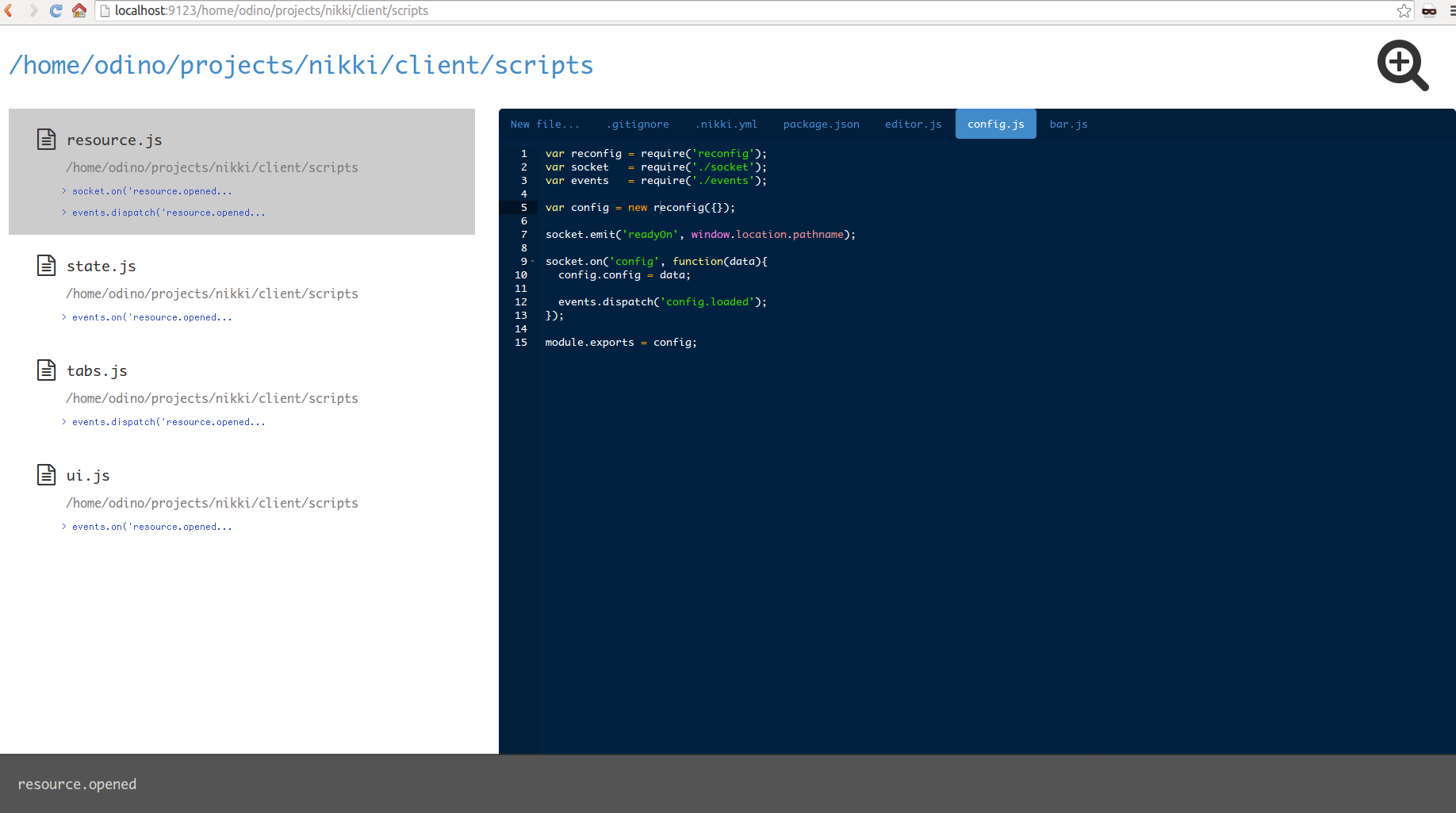nikki
v0.28.1
Published
A browser-based IDE written in NodeJS. For Real.
Downloads
75
Maintainers
Readme
Nikki
A fast, browser-based IDE written in NodeJS. For Real.
Nikki's philosophy embraces the "less is better" approach, giving you a smart text editor that lets you focus on code rather than making you waste your time waiting for the IDE to boot, to suggest a method or to scan a new project.
Nikki is purely built on JavaScript (both on the browser and on Node), HTML and CSS, uses socket.io to have fun with your filesystem and the ACE editor to let you edit files like you're on your (ex) favourite IDE.
Installation
The recommended way to install nikki is to do it globally:
npm install -g nikkiUsage
Once you have it installed globally you can simply start nikki from the command line:
nikkiThis command will open your browser at http://localhost:9123/,
where the IDE is running.
To open specific project, simply specify it in the URL, for
example http://localhost:9123/home/odino/my-project.
You can check whether nikki is runnin with a nikki --status;
if you want to stop nikki simply run nikki --stop.
If you wish to start nikki on another port, simply specify it once you start the IDE:
nikki --port 8000By default, nikki opens on the directory from which it was launched, which means that:
cd /tmp
nikkiwill open the browser at http://localhost:9123/tmp
If you feel lost, simply run a nikki --help and get some comfort;
in any case, upon booting, you will find a nikki.log file
in nikki's root directory: in case of errors, have a look there.
Configuration
By default, nikki comes with some configs stored
in the .nikki.yml
file of the module itself; you can setup custom
configs by storing a .nikki.yml file in your home
directory, or in the directory from which you are starting
nikki.
For example, to change the editor theme, you can
create the .nikki.yml configuration file in ~:
editor:
theme: chaosFor a full list of available configurations, have a look here.
If you want to be more granular and specify
per-project configurations, you can do it by
storing another .nikki.yml in your project's
folder (ie. /home/user/projects/test-project/.nikki.yml):
once you open nikki at localhost:9123/home/user/projects/test-project
you will see that you are now using custom configurations
that will only be available on that project.
Shortcuts
Nikki is thought with shortcuts in mind and focused on letting you write code without using your mouse.
Here are some of the shortcuts you might find useful
while using it (on Macs, simply replace ctrl with ⌘):
- use
upordownto move between files / directories - press
spaceto open a file / directory ctrl + swill save the current open filectrl + fto find a string in the current filectrl + shift + fwill search for files and directoriesctrl + shift + gwill search in files- press
ctrl + shift + xto switch the focus between the filesystem structure and the editor tab (this is handy when you open a file, save it and then wanna open another file without using the mouse) - press
deleteto delete either a file or a directory
When you are on the editor tab, use your usual shortcuts
(ie. tab to indent, ctrl + z to undo), as we are using
the ACE editor.
To switch between editor tabs, press ctrl + < and ctrl + >;
to close a tab simply use ctrl + shift + l.
For a full list of keyboard shortcuts supported by the editor visit its documentation.
File / directory search
When the search is enabled (ctrl + shift + f),
you can use a single word or a
sequence of words to match a path; long story short:
appmatchesapp.jsandapp_production.jsapp prodonly matchesapp_production.jsproj appmatches/some/path/project/app.js
Nikki will look for files from the current directory onwards.
Support
Nikki should work on all modern browser: for an optimal experience, though, we recommend the latest versions of Chrome and Firefox.
Development
You can contribute to nikki by simply forking this repo and
running it locally; cd into nikki's root, run npm install
and launch the app with gulp:
git clone [email protected]:odino/nikki.git
cd nikki
npm install
gulpBy the way, the layout sucks, big time: never been a genious with HTML and CSS so if you guys wanna come up with something I'd be super happy.
License
For the ones who care, nikki is released under the MIT license.
Are you for real?
"Kinda", "Why not?" and "Let's just have fun" are all valid answers to this question.
Of course, calling this thing an "IDE" is a bit - well, a lot - pretentious. On purpose ;-)
The main idea behind nikki came up to my mind months ago when I was thinking on why we are still relying on desktop applications to interact with the filesystem while we can simply use sockets to make the browser communicate, in a simple way, with the server. At the same time, I got so much frustrated with traditional IDEs like Eclipse, Netbeans, WebStorm: tried all of them and it's just ridicolous how much time you spend in waiting for that thing to respond to your actions.
Hey, couldn't you simply use TextMate or LightTable?
Yes, but then, where's the fun?
Bonus
The sickest thing is that I started building Nikki with WebStorm and, once it got quite decent, I continued to build Nikki with Nikki.

